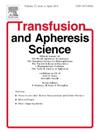同种异体干细胞移植预防GVHD的移植后环磷酰胺的最佳剂量是多少?
IF 1.4
4区 医学
Q4 HEMATOLOGY
引用次数: 0
摘要
目的:在这项研究中,我们旨在比较使用两种不同剂量环磷酰胺(PTCy)的可变强度调节方案治疗血液系统恶性肿瘤患者的移植天数、移植物抗宿主病(GVHD)的发展、复发和总生存率。材料和方法:我们回顾性分析了2018年至2024年间接受PTCy剂量为25 mg/kg × 2和50 mg/kg × 2的162例患者。患者分为两组;PTCy剂量为25 mg/kg × 2(第一组,n = 45)和50 mg/kg × 2(第二组,n = 117)。比较各组移植时间、GVHD、复发率和OS率。结果:所有患者均行清髓调理方案和外周血干细胞收集移植。61.1 %的患者(n = 99)还活着在研究结束时(60 % (n = 27)在Group1和61.5 %组(n = 72)2)。在组1组2中的平均随访6.9个月,这是7个月;第1组中位OS为15.5个月,第2组中位OS为49.5个月,但差异无统计学意义(Log rank = 0.796)。1组血小板移植时间为13 d,中性粒细胞移植时间为17 d;在组2中,血小板为18天;中性粒细胞17天;这在血小板中有统计学意义,但在中性粒细胞移植中无统计学意义(p分别< 0.001和p:0.839)。1组18例(40 %),2组27例(23 %)出现急性GVHD (aGVHD)。1组aGVHD发生率高于2组(p = 0.031)。1组7例(15.5 %),2组6例(5.12 %)存在慢性GVHD (cGVHD)。1组cGVHD发生率高于2组(p = 0.048)。第1组25例(55.6% %)和第2组19例(16.2% %)复发(p )。结论:本研究显示两组患者的生存率无差异。血小板植入时间在PTCy 25 mg/kg × 2剂量组较移植后50 mg/kg × 2剂量组短。25 mg/kg × 2剂量组aGVHD和cGVHD发生率均较高。当PTCy剂量为25 mg/kg × 2时,复发更为常见。本文章由计算机程序翻译,如有差异,请以英文原文为准。
What should be the optimal dose of post-transplantation cyclophosphamide for GVHD prophylaxis in allogeneic stem cell transplantation?
Objectives
In this study, we aimed to compare the engraftment days, graft versus host disease (GVHD) development, relapse and overall survival (OS) rates in patients using variable intensity conditioning regimens with two different post-transplant cyclophosphamide (PTCy) doses for hematological malignancies.
Material and methods
We retrospectively analyzed 162 patients who have had PTCy at a dose of 25 mg/kg × 2 and 50 mg/kg × 2 between 2018 and 2024. Patients were divided in 2 groups; PTCy dose with 25 mg/kg × 2 (Group 1, n = 45) and PTCy dose with 50 mg/kg × 2 (Group 2, n = 117). The engraftment days, GVHD, relapse and OS rates were compared across groups.
Results
All patients had myeloablative conditioning regimens and peripheral stem cell collected transplantation. 61.1 % of patients (n = 99) were alive at the end of the study (60 % (n = 27) in Group1 and 61.5 % (n = 72) in Group 2). In Group 1 the median follow-up was 6.9 months and in Group 2 this was 7 months; the median OS was 15.5 months in Group 1 and 49.5 months in Group 2 but this is not statistically significant (Log rank = 0.796). In Group 1, the engraftment times for platelets was 13 days, for neutrophils 17 days; in Group 2, for platelet this was 18 days; and for neutrophils 17 days; this was statistically significant for platelets but not for neutrophil engraftment (p: < 0.001 and p:0.839, respectively). Eighteen patients (40 %) in Group 1 and twenty-seven (23 %) patients in group 2 had acute GVHD (aGVHD). In Group 1 aGVHD rates were higher than Group 2 (p = 0.031). Seven patients (15.5 %) in Group 1 and 6 (5.12 %) patients in group 2 had chronic GVHD (cGVHD). In Group 1 cGVHD rates were also higher than Group 2 (p = 0.048). Twenty-five patients (55.6 %) in Group 1 and 19 patients (16.2 %) in Group 2 had relapsed disease (p < 0.001).
Conclusion
Our study showed that there were no differences in survival across the groups. The platelet engraftment time was shorter for the PTCy 25 mg/kg × 2 doses compared to the post-transplantation 50 mg/kg × 2 doses. Both aGVHD and cGVHD rates were higher in 25 mg/kg × 2 dose treated patients. Relapses occurred more commonly with 25 mg/kg × 2 PTCy dose.
求助全文
通过发布文献求助,成功后即可免费获取论文全文。
去求助
来源期刊
CiteScore
3.60
自引率
5.30%
发文量
181
审稿时长
42 days
期刊介绍:
Transfusion and Apheresis Science brings comprehensive and up-to-date information to physicians and health care professionals involved in the rapidly changing fields of transfusion medicine, hemostasis and apheresis. The journal presents original articles relating to scientific and clinical studies in the areas of immunohematology, transfusion practice, bleeding and thrombotic disorders and both therapeutic and donor apheresis including hematopoietic stem cells. Topics covered include the collection and processing of blood, compatibility testing and guidelines for the use of blood products, as well as screening for and transmission of blood-borne diseases. All areas of apheresis - therapeutic and collection - are also addressed. We would like to specifically encourage allied health professionals in this area to submit manuscripts that relate to improved patient and donor care, technical aspects and educational issues.
Transfusion and Apheresis Science features a "Theme" section which includes, in each issue, a group of papers designed to review a specific topic of current importance in transfusion and hemostasis for the discussion of topical issues specific to apheresis and focuses on the operators'' viewpoint. Another section is "What''s Happening" which provides informal reporting of activities in the field. In addition, brief case reports and Letters to the Editor, as well as reviews of meetings and events of general interest, and a listing of recent patents make the journal a complete source of information for practitioners of transfusion, hemostasis and apheresis science. Immediate dissemination of important information is ensured by the commitment of Transfusion and Apheresis Science to rapid publication of both symposia and submitted papers.

 求助内容:
求助内容: 应助结果提醒方式:
应助结果提醒方式:


